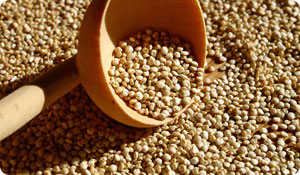
See what people are saying about this article on our Facebook page!![]()
Once considered a mere provision for people in third world countries, this tasty, nutritious little seed has become a favorite among natural food lovers everywhere.
Quinoa—pronounced keen-wah, with an emphasis on keen—is a high-protein seed that is eaten like a grain. It can be substituted in many different types of recipes that normally call for cracked wheat, wheat berries, bulgur, barley, millet, brown or wild rice, and other starchy grain and cereal foods. Unlike many grains, quinoa is gluten-free.
What makes quinoa so attractive to nutrition-conscious eaters is its amino acid profile, which ultimately provides high-quality protein in the diet. In particular, quinoa is notable for its high levels of the essential amino acid lysine, which is only found in high-protein foods. Lysine must come from your diet in order for your body to make complete proteins and it is most commonly found in meat, poultry, fish, eggs, cheeses and other animal foods. Besides soy beans and other legumes, vegetarians and people who eat limited amounts of animal products, have few very good sources of lysine.
Lysine helps your body use up fat for energy, lower cholesterol, absorb calcium, and maintain healthy skin and cartilage. Too little lysine can lead to fatigue, nausea, anemia, and reproductive disorders.
In its natural form, the quinoa seed is coated with bitter, toxic substances known as saponins that must be washed off or otherwise removed from the surface before eating. The most popular commercial brands of quinoa are sold polished and pre-washed so the saponins have been removed. Scientific efforts in plant breeding have also produced low-saponin varieties of quinoa.
Preparing quinoa is quick and easy. After a good rinse to ensure no saponin residue remains, combine two parts water and one part quinoa (for instances, 2 cups water and 1 cup quinoa) in a medium-size saucepan and add a pinch of salt. Bring to a boil over medium heat; reduce to heat to low and simmer for 15 minutes or until tender. You know quinoa is ready to eat when a tiny white sprout pops out and spirals around each seed.
Try quinoa tossed in an olive oil and lemon vinaigrette or with pesto and parmesan cheese or combined with lentils in a soup or salad. Substitute cooked quinoa for bulgur or cracked wheat in tabbouleh salad or use it in place of rice in a pilaf or stuffed pepper. Cooked quinoa also makes a great thickener for soups and extender for ground meat and poultry mixtures used to make meatballs, meatloaf and burgers. You can also try quinoa for breakfast, in place of oatmeal or other hot cereals and topped with fruit and berries.
See what people are saying about this article on our Facebook page!![]()
Sources:
United Nations University: A Lesser-Known Grain, Chenopodium Quinoa-Review of the Chemical Composition of its Edible Parts.
http://unu.edu/unupress/food/V191e/ch10.htm#b2-A%20lesserknown%20grain,%20Chenopodium%20quinoa%20Review%20of%20the%20chemical%20composition%20of%20its%20edible%20parts
University of Maryland Medical Center: Lysine
http://www.umm.edu/altmed/articles/lysine-000312.htm





